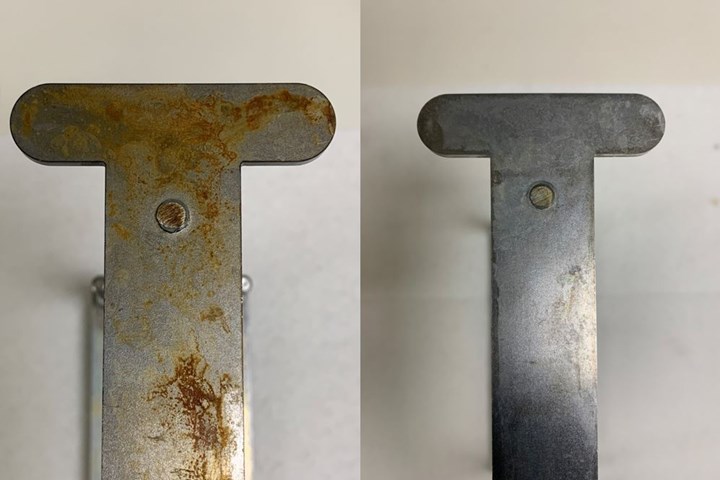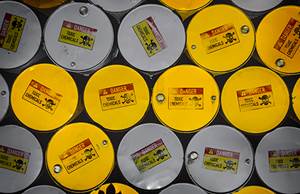Role of pH in Cleaning Chemicals
Learn about when to use which type of chemical cleaner for an application, and how understanding the pH scale in this situation is beneficial.
Q: How does pH come into play when deciding which chemical is right for my cleaning process?
A: Let’s begin answering by first posing a couple of other questions. Do you remember the lessons taught in your high school chemistry class? Remember those countless lab experiments with litmus paper? Chances are you didn’t think those preliminary chemistry lessons would help you choose the best chemical for the parts cleaning jobs you’re currently facing, but many successful manufacturing cleaning processes heavily depend on the chemistry involved. A simple understanding of the pH of chemical cleaners can save you time and headaches.
The pH scale is a system that determines the acidity or basicity of a solution. The scale ranges from 0 to 14, with 7 being neutral. Numbers 0 to 6 are considered acidic, while numbers 8 to 14 are basic. The strongest acids are at the lowest end of the scale, while the strongest bases sit at the highest end.
This information is useful background knowledge to have, but how can we apply this? Let’s dive in.
The contrast in pH between acidic and basic solutions enables them to have different functions. Phosphoric acid, hydrofluoric acid, citric acid and tartaric acid are examples of acidic compounds. They are generally formulated into aqueous solutions for safer operation. Acidic cleaners are best used to remove rust, oxidation and mineral deposits, and they brighten the surface of certain metals such as brass and aluminum. The stronger the acid, the lower the pH and the more effective it may be to remove that tough contaminant. It is important to read the material safety data sheet to check the concentration of the acid in the formulation because the aggressiveness of the acid is critical. An acidic chemical containing a strong acid and high concentration can remove the desired pollution, but may damage the surface of the material. It’s all about finding balance.

This oxidized piece of steel is shown before (left) and after ultrasonic immersion in a diluted acid-based solution. Photo credit: NGL Cleaning Inc.
When most people think of a chemical cleaner, odds are the cleaner they are referring to is basic. This is because basic chemicals are typically the standard pH used for both industrial and household cleaners. Sodium hydroxide, potassium hydroxide and ammonium hydroxide are examples of basic compounds. Basic cleaners are best used to remove oil, fats, grease and various soils. A strong base concentration in the formulation may damage the surface if the properties of the material are not adequate.
Both acidic and basic cleaning chemicals have additional compounds in their formulation that help take their cleaning properties one step further. Compounds such as surfactants, solvents, sequestering agents and specific inhibitors help the chemical adjust to various applications. A basic chemical cleaner may be made to remove oil from similar metals with no issue, but what happens when metal with different properties must be cleaned? Cemented tungsten carbide, for example, is a popular material used for cutting tools which is embedded in a cobalt matrix. Under corrosive conditions (such as immersion in an aqueous solution), the cobalt may release, which is called cobalt leaching. To prevent this from occurring, the basic chemical solution must have cobalt leaching inhibitors to prevent the dissolution of the cobalt matrix, leaving a clean, perfect, undamaged surface finish.
With over 40 years of expertise, NGL Cleaning Inc.’s technology has a variety of chemical solutions to help solve the toughest manufacturing cleaning problems. The company offers acidic, basic or neutral chemicals.
About the Author
Alejandro Lara
Alejandro Lara is an application engineer at NGL Cleaning Inc. Contact: ngl-group.com, usa@ngl-group.com, 630-216-8300.
Related Content
A ‘Clean’ Agenda Offers Unique Presentations in Chicago
The 2024 Parts Cleaning Conference, co-located with the International Manufacturing Technology Show, includes presentations by several speakers who are new to the conference and topics that have not been covered in past editions of this event.
Read MoreIn-line Monitoring for Automated Immersion Cleaning Systems
Ecoclean’s Acoustic Performance Measurement (APM) system provides in-line measurement of ultrasonic frequency and power in fully automated immersion cleaning systems on a batch-by-batch basis or at defined time intervals, such as once a shift, day or week.
Read MoreParts Cleaning Sector Shifts Energy Toward Regulatory Changes
With changes in EPA regulations regarding the use of some popular cleaning fluids, cleaning suppliers and end users are readjusting business strategies and/or cleaning processes to meet new requirements.
Read MoreIndustrial Cleaning Shop Zeros In on Precision
This parts cleaning company is elevating its efforts to become a technical cleanliness expert, which presents an exciting, yet sometimes arduous, journey. The ongoing education of the team as well as significant investments in equipment and processes attribute to this shop’s success.
Read MoreRead Next
Is Cleaning with Solvent More Beneficial than Aqueous Cleaning?
To understand solvent-based and aqueous cleaning methods, Venesia Hurtubise, technical chemist, MicroCare Corp., has compiled the following details about both processes.
Read MoreHeat’s Impact on Parts Cleaning
Thermal dynamics is important for assisting in the cleaning of a part. Adding heat or energy influences the cleaning process through its impact on chemistry, the water within the washer and its effect on drying.
Read MoreAligning Parts Cleaning with a Metalworking Program
Effective cleaning of machined or formed parts is a key step in virtually all manufacturing processes, but is too often overlooked.
Read More






















